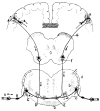Circuit reconstruction tools today
- PMID: 18082394
- PMCID: PMC2693015
- DOI: 10.1016/j.conb.2007.11.004
Circuit reconstruction tools today
Abstract
To understand how a brain processes information, we must understand the structure of its neural circuits-especially circuit interconnection topologies and the cell and synapse molecular architectures that determine circuit-signaling dynamics. Our information on these key aspects of neural circuit structure has remained incomplete and fragmentary, however, because of limitations of the best available imaging methods. Now, new transgenic tool mice and new image acquisition tools appear poised to permit very significant advances in our abilities to reconstruct circuit connection topologies and molecular architectures.
Figures



References
-
- Ramon y Cajal S. In: Histology of the Nervous System of Man and Vertebrates. Swanson N, Swanson L, editors. Oxford Press; 1995. Summarizes the work that first placed the concept of information processing by neural circuit structures on a firm anatomical foundation.**
-
- Nelson SB, Hempel C, Sugino K. Probing the transcriptome of neuronal cell types. Curr Opin Neurobiol. 2006 Oct;16(5):571–6. Epub 2006 Sep 7. - PubMed
-
- Molyneaux BJ, Arlotta P, Menezes JR, Macklis JD. Neuronal subtype specification in the cerebral cortex. Nat Rev Neurosci. 2007;6:427–437. - PubMed
-
- Lein ES, et al. Genome-wide atlas of gene expression in the adult mouse brain. Nature. 2007;445:168–176. - PubMed
Publication types
MeSH terms
Grants and funding
LinkOut - more resources
Full Text Sources

